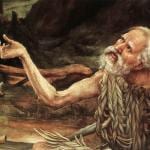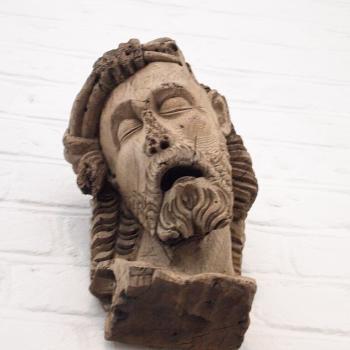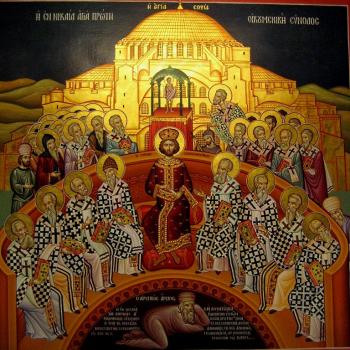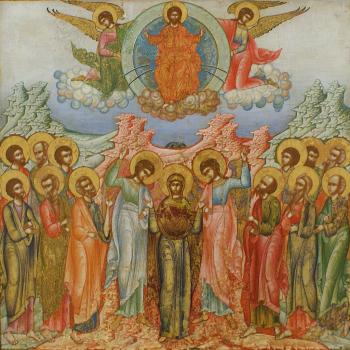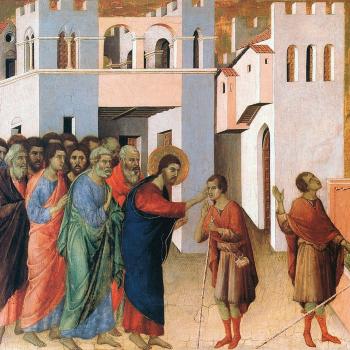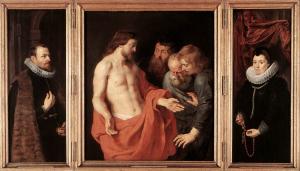
On the first day of the week (Sunday), but also, counting through the days of one week and going to the beginning of the next week, on the eight day, Jesus rose from the dead. This is why the eighth day is said to represent the beginning of eternity. The whole time in which God is said to have created everything and let it be is said to be one week. That week of creation is now transcended by the eighth and eternal day. The eighth days is new. It transcends the time established for creation. It takes us to the eschaton, that is, to the eternal day of the Lord. The eighth day is the repetition and fulfillment of the first, where all that exists in time finds its properly restored place in eternity. Thus, St. Bonaventure writes:
When the third day dawned of the Lord’s sacred repose in the tomb, which in the cycle of the week is both the eighth and the first, Christ, the power and wisdom of God (1 Cor. 1:24), with the author of death lying prostrate, conquered even death itself and opened to us access to eternity, when he raised himself from the dead by his divine power in order to make known to us the paths of life (Ps. 15:11).[1]
This is why it was appropriate to say that eight days after first appearing to most of his apostles, Jesus once again visited them. The first time, Thomas was not with them; the second time, he was:
Now Thomas, one of the twelve, called the Twin, was not with them when Jesus came. So the other disciples told him, “We have seen the Lord.” But he said to them, “Unless I see in his hands the print of the nails, and place my finger in the mark of the nails, and place my hand in his side, I will not believe.” Eight days later, his disciples were again in the house, and Thomas was with them. The doors were shut, but Jesus came and stood among them, and said, “Peace be with you.” Then he said to Thomas, “Put your finger here, and see my hands; and put out your hand, and place it in my side; do not be faithless, but believing.” Thomas answered him, “My Lord and my God!” Jesus said to him, “Have you believed because you have seen me? Blessed are those who have not seen and yet believe” (Jn. 20:24-29 RSV).
The first encounter the apostles had with Jesus was on the first day of the week, or the symbolic eighth day, while the second event, repeating the first, happened eight days later in order to emphasize the symbolism of the eighth day. Thomas, the twin, was not originally there on the day of resurrection. However, he was able to experience the twin-event, and in doing so, represent not just himself, but all of us, as we are called to experience and participate in the resurrection of Christ.
The Paschal celebration is able to be repeated. It is not bound to one day. In order for us to understand this, Jesus waited until Thomas the twin, or double, was with the rest of the apostles to reveal himself once again. Thomas, it is said, was doubtful of the resurrection. He indicated that he would only believe in the resurrection if he could touch Jesus’ hands and feet. Jesus, understanding Thomas’ doubt, revealed himself to Thomas, telling him to doubt no more. And because of what Thomas had previously said, Jesus told Thomas to feel free to touch him, to see that Jesus truly had risen from the dead.
Did Thomas touch Jesus, or did he simply believe without having to do so? We are not told; we are only told of Thomas’ belief. St. Augustine was not sure. On the one hand Jesus told him to do so, so it would seem that he did, but on the other hand, would he dare touch Jesus once he has seen him in his resurrected form? Either way, it is suggested that Thomas believed because he saw the resurrected Christ:
Hence here also the Lord Himself says, “Reach hither your finger, and behold my hands:” and what else does He mean but, Touch and see? And yet he had no eyes in his finger. Whether therefore it was by looking, or also by touching, “Because you have seen me,” He says, “you have believed.” Although it may be affirmed that the disciple dared not so to touch, when He offered Himself for the purpose; for it is not written, And Thomas touched Him. But whether it was by gazing only, or also by touching that he saw and believed, what follows rather proclaims and commends the faith of the Gentiles: “Blessed are they that have not seen, and yet have believed.” He made use of words in the past tense, as One who, in His predestinating purpose, knew what was future, as if it had already taken place. But the present discourse must be kept from the charge of prolixity: the Lord will give us the opportunity to discourse at another time on the topics that remain.[2]
This story was written down for our benefit. The Easter event is not only doubled, or “twinned” with Jesus meeting Thomas, it is doubled or twinned in us and with us both when we come to believe and experience the resurrected Christ for ourselves. We can believe without having such an experience, and if we do so, we are told we are blessed. It is clear that much grace comes out of such faith. But there comes a time in which all of us will come to experience the resurrected Christ, to come to believe in him through our own encounter with him. This is what the story of Thomas truly signifies, the way in which the resurrection event is capable of transcending its historical foundation, allowing all of us to experience the glory of the resurrected Christ. Then, when we do, there will be no more questions, no more doubt, just the awe which we see expressed in the words of Thomas: “My Lord and my God.”
Jesus, in his resurrection appearance, removed all doubt from Thomas. This does not mean Thomas was left without faith. Rather, that faith became transformed. When we encounter the majestic wonder of God, we are moved beyond a simple propositional faith with all the doubts such a faith entails. We are moved outside of ourselves, outside of all our thoughts and words, into the great abyss of the mystery of God. It is glorious and majestic, but it can also be frightening and confusing at the same time. The more we experience the glory of God, the more our questions fade away, leaving pure faith in its wake. That faith is different than what it was beforehand. The more we see and experience the grandeur of God, the more we will see and experience the great and wonderful but yet fiery love of God. We will rush to him, having faith that he will not annihilate us in his all-consuming fire. We put our love and trust in him. We will join in that fire, in the glory of God. We will find ourselves consumed but not destroyed by it as we see God transforms us in and through it, making truly one with Christ. Then, to our great joy, we will find the resurrection of Christ taking place within our very being. It will still be a great mystery, and with that mystery leaving us with new ways in which we have faith in God, but it will be a faith beyond all conceptions, beyond deliberation, beyond all that we initially used to get us to believe in Christ.
We must take the leap of faith with hope and love. When we encounter the fiery glory of God, this is easier said than done. But this is where true faith comes into play. Faith is far than having the right belief about some element of the truth. This is why those who study doctrine and know what it teaches and believe it might be faithless, while those who do not, might have great faith.
Faith requires us to truly open ourselves up to God and to let him do with us as he wishes with us. It is not an easy thing. It is frightening. We, therefore, find ourselves often doubting God – not because we do not know and in that respect believe what he said he would do he would do. Rather, we find ourselves all confused and dumbfounded in the cloud of God’s glory. In it, we shall begin to find ourselves losing all things, including ourselves; this, more than any other time, is when we must reach out to him in faith and love. We must let God recreate us and help us to truly experience the fullness of the resurrection from the dead. Thomas, in this sense, can be seen as representing us as we are in the midst of such a reformation; we cannot touch and see the resurrection within until we are ready.
There are many ways to experiences the glory of the eighth day. This is because the day of resurrection is the day of the Lord, the eschatological day which transcends all time and space. Each instance, each encounter of the resurrected Christ, is an experience of the eschatological eight day, the eternal day which has no end. Thus, Thomas, the twin, represents all the ways which the resurrection of Christ can be experienced or doubled, from the historical experience, in which Thomas is said to have met with Jesus eight days after the rest of the apostles, to the mystical encounter, which God graces some of us to have, to the experience of the resurrection at the end of our temporal existence (which we experience in our death). The day of the resurrection is the eternal day of the Lord, the eschatological kingdom of God, the reign of Christ which has no end. In Jesus, the two are bridged, so that we can encounter it while in history, but also when we die. Each way we experience the resurrection, we will be like Thomas, doubling him, saying “My Lord and my God.” And each time we praise God in that way, we will do so with new and greater meaning, new and greater faith, new and greater love.
Let us, therefore, say “Christ is risen,” and hopefully come to experience that “Truly, he is risen!” Let us experience the risen Christ, not only in history, but also within ourselves. Then we can be people of such faith, hope and love, we will reveal the truth of the resurrection to all. We need to move beyond a propositional faith to a living faith. Certainly, in the transition between one to the other, we must not deny the value of the propositional faith. Instead, we should see its limitations and how it only initiates us into the greater faith, the greater life, which we are meant to have. We must not deny the truths put forward in such propositions, but rather, we shall let them be realized in the transcendent spirit of the resurrection. It is easy for us to get stuck in the letter of the faith; to do so is itself to remain like Thomas in doubt of the resurrection itself:
Thomas means double, which signifies “doubt,” or a person who is of “doubtful mind,” which is why he would not believe in the resurrection of the Word until he had touched the marks of the nails. Thomas therefore is every doubting man who finds it difficult to believe that the resurrection of virtue and knowledge of the Word takes place within him.[3]
It is when we let go and detach ourselves from all things, including our intellectual occupations, all doubt can also be cast aside and we can truly experience the glory of the resurrection within. This is not to say we do not experience it in part before we do this; insofar as we believe, insofar as we have faith, however little it is, however imperfect it is, there we find the work of the spirit already enlivening us and making us a part of the kingdom of God. What we must do is remove all the barriers we have between us and the kingdom, between us and the eschatological glory of the resurrection; then we shall find that we were there all along. This is why St Maximos says Thomas’ doubt represents the doubt of the virtue and knowledge which takes place in us: for Maximos points out that it truly is taking place, just that we have not fully realized it and so have our doubts about it. Once the barrier is cast aside, we will see Christ was already there with his grace, influencing us, helping us, strengthening us, indeed transforming us, in the hidden recesses of our being.
Thomas is us. We are Thomas. Let us truly set our minds on Christ. Then we too shall be able to say in perfect faith and love, “My Lord and my God” when we encounter him in his resurrected glory.
[1] St. Bonaventure, “The Tree of Life” in Bonaventure: The Soul’s Journey into God; The Tree of Life; The Life of St. Francis. Trans. Ewert Cousins (New York: Paulist Press, 1978). 159-60.
[2] St. Augustine, Tractates on John in NPNF1(7):439.
[3] Saint Maximos the Confessor, On Difficulties in the Church Fathers: The Ambigua. Volume II. Trans. Nicholas Constas (Cambridge: Harvard University Press, 2014), 257 [Amb. 58].
Stay in touch! Like A Little Bit of Nothing on Facebook.
If you liked what you read, please consider sharing it with your friends and family!



